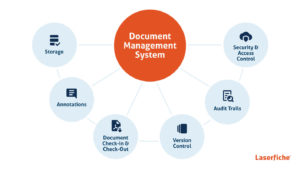Organizations and teams increasingly rely on document management in order to conduct business. They are producing content at an ever-increasing rate, and today’s documents, now mostly digitized, stay around a lot longer than they did in the days of paper.
In fact, according to the Association for Intelligent Information Management (AIIM), on average, organizations expect the volume of information coming into their organizations to grow from X to 4.5X over the next two years.
When unaddressed, these challenges can result in:
- Siloed desktops
- Cluttered network drives
- Unorganized databases
With information scattered between individuals and teams, documents can become missing, outdated, unsecured, and in a worst-case scenario, even compromised by an unauthorized party.
For example, employees could end up working with missing or incomplete information, hindering efficiency and productivity. For heavily regulated industries, unsecured documents can be a compliance risk, and consequently a financial liability. Compromised documents can present an even more serious security risk, creating the possibility of information falling into the wrong hands.
What is document management?
Document management is a set of practices that define how an organization manages, stores and tracks its documents.
Documents come in a wide variety of formats, from contracts and forms to images and emails. However, whatever form documents take, the principles of document management stay consistent. The common components of document management include:
- Storage:Provide a centralized location for documents that’s easy for authorized parties to access and search.
- Annotations:Add notes or comments to a document without needing to edit the document itself.
- Check-in and check-out:Ensure that changes to documents by different users don’t overwrite each other, with a system that only allows for one party to make edits at a time.
- Version control:Track and record changes in real time so that with each new version of the document, you can view the edit history and roll back to a previous version if needed.
- Audit trails:Support your compliance initiatives by enabling authorized users to view a log of who has viewed or edited your documents, and when.
- Security and access control:Do everything possible to ensure access to documents is limited only to authorized parties. This is especially important in highly regulated industries.

These components play an important role in securing your organization’s information. That’s why it is important to select the right tools and technologies to take full advantage of them. This is where a document management system comes in.
What are the benefits of a document management system?
A document management system is designed to make it easier, and in many ways, automatic, for you to implement standard document management practices and procedures. By implementing a document management system, any organization can get their documents in order and take advantage of the following benefits:
- Increase transparency across the enterprise:Whether reviewing contracts, processing invoices or collecting forms, it’s essential that employees can find the right documents when they need them. A document management system puts documents all in one place, ensuring that employees are working with the same set of information. This centralized repository of critical documents can serve as a source of truth across the organization.
- Quickly search through multiple documents:Regardless of size and format, the right document management system can make every document full-text searchable. This enables employees to find the information they need, whether it’s in a document’s title, its metadata or deep within the full text. New technology such as artificial intelligence and machine learning can further enhance a document management system’s ability to extract information from documents.
- Securely share content internally and externally:It’s critical for many organizations to share documents with customers safely and securely. The right document management system can provide specialized functionality for this purpose, storing the document in a secure location, ensuring that it is shared for only a limited time, and enhancing transparency by logging who accessed what documents and when.
- Foster employee and organizational collaboration:When employees are working on a document together, advanced document management systems enable them to collaborate on a document in real-time. This process can be a boon in removing the back-and-forth of editing through email threads and getting final versions of documents out faster.
- Keep track of major revisions:Feature-rich document management systems have built-in version control. This helps employees track document changes and ensure that the document they’re working with is the most up-to-date version that exists.
- Protect sensitive information:With a document management system, administrators can grant or deny access to information as needed. This helps your organization ensure that documents can be accessed by authorized users and no one else.
- Support compliance efforts:Most document management systems provide audit trails “ logs of system activity, including document edits, login attempts and user permission changes. This functionality helps to show auditors that your organization is following regulations and that system security measures are effective.
- Access information securely from anywhere with cloud document management:With today’s cloud technologies, employees can now access document management systems from wherever they are in the world. This ease of access, combined with the security that advanced document management systems can provide, offers a secure and effective way to ensure information can be communicated between project stakeholders, no matter where they are. Additionally, many cloud systems automatically back up content, providing a foundation for quick recovery in case of a disaster or disruption to business.
There are many ways a document management system can benefit organizations and improve their operations. In addition, as the digitization and adoption of cloud document management becomes more widespread, there are increasingly quick, efficient and secure ways of delivering this functionality to organizations.
To learn more about the benefits and uses of document management, along with advice and insights on how to procure a system for your organization, download The Document Management Software Buyer’s Guide.
